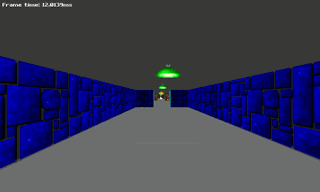- android - RelativeLayout 背景可绘制重叠内容
- android - 如何链接 cpufeatures lib 以获取 native android 库?
- java - OnItemClickListener 不起作用,但 OnLongItemClickListener 在自定义 ListView 中起作用
- java - Android 文件转字符串
我正在为大学编写仅使用核心 OpenGL 3.3 的 Wolfenstein 3D 的克隆,但我遇到了一些 Sprite 问题,即让它们根据距离正确缩放。
据我所知,以前版本的 OGL 实际上会为您执行此操作,但该功能已被删除,我所有重新实现它的尝试都以失败告终。
我目前的实现在远距离还算过得去,中距离不太差,近距离也不太奇怪。
主要问题(我认为)是我不了解我正在使用的数学。
Sprite 的目标大小比视口(viewport)稍大,所以当你接近它时它应该“走出画面”,但事实并非如此。它变小了,这让我很困惑。
我录制了一个小视频,以防文字不够。 (右边是我的)


谁能告诉我哪里出错了,并解释原因?
代码:
C++
// setup
glPointParameteri(GL_POINT_SPRITE_COORD_ORIGIN, GL_LOWER_LEFT);
glEnable(GL_PROGRAM_POINT_SIZE);
// Drawing
glUseProgram(StaticsProg);
glBindVertexArray(statixVAO);
glUniformMatrix4fv(uStatixMVP, 1, GL_FALSE, glm::value_ptr(MVP));
glDrawArrays(GL_POINTS, 0, iNumSprites);
顶点着色器
#version 330 core
layout(location = 0) in vec2 pos;
layout(location = 1) in int spriteNum_;
flat out int spriteNum;
uniform mat4 MVP;
const float constAtten = 0.9;
const float linearAtten = 0.6;
const float quadAtten = 0.001;
void main() {
spriteNum = spriteNum_;
gl_Position = MVP * vec4(pos.x + 1, pos.y, 0.5, 1); // Note: I have fiddled the MVP so that z is height rather than depth, since this is how I learned my vectors.
float dist = distance(gl_Position, vec4(0,0,0,1));
float attn = constAtten / ((1 + linearAtten * dist) * (1 + quadAtten * dist * dist));
gl_PointSize = 768.0 * attn;
}
片段着色器
#version 330 core
flat in int spriteNum;
out vec4 color;
uniform sampler2DArray Sprites;
void main() {
color = texture(Sprites, vec3(gl_PointCoord.s, gl_PointCoord.t, spriteNum));
if (color.a < 0.2)
discard;
}
最佳答案
首先,我不太明白你为什么要使用pos.x + 1。
接下来,就像Nathan说的,你不应该使用clip-space点,而应该使用eye-space点。这意味着您仅使用模型 View 转换点(没有投影)来计算距离。
uniform mat4 MV; //modelview matrix
vec3 eyePos = MV * vec4(pos.x, pos.y, 0.5, 1);
另外我不完全理解你的衰减计算。目前,较高的 constAtten 值意味着衰减较少。为什么不直接使用 OpenGL 已弃用的点参数所使用的模型:
float dist = length(eyePos); //since the distance to (0,0,0) is just the length
float attn = inversesqrt(constAtten + linearAtten*dist + quadAtten*dist*dist);
编辑:但总的来说,我认为这种衰减模型不是一个好方法,因为通常你只是想让 Sprite 保持它的对象空间大小,你不得不摆弄衰减因子实现我认为的目标。
更好的方法是输入其对象空间大小,然后根据当前 View 和投影设置计算屏幕空间大小(以像素为单位)(gl_PointSize 实际上是这样):
uniform mat4 MV; //modelview matrix
uniform mat4 P; //projection matrix
uniform float spriteWidth; //object space width of sprite (maybe an per-vertex in)
uniform float screenWidth; //screen width in pixels
vec4 eyePos = MV * vec4(pos.x, pos.y, 0.5, 1);
vec4 projCorner = P * vec4(0.5*spriteWidth, 0.5*spriteWidth, eyePos.z, eyePos.w);
gl_PointSize = screenWidth * projCorner.x / projCorner.w;
gl_Position = P * eyePos;
这样,当渲染为宽度为 spriteWidth 的带纹理的四边形时, Sprite 始终会获得它应有的大小。
编辑:当然,您还应该牢记点 Sprite 的局限性。点 Sprite 根据其中心位置进行裁剪。这意味着当它的中心移出屏幕时,整个 Sprite 就会消失。对于大型 Sprite (我认为就像您的情况一样),这可能真的是个问题。
因此我宁愿建议您使用简单的纹理四边形。这样您就可以绕过整个衰减问题,因为四边形就像所有其他 3d 对象一样被转换。您只需要实现朝向观察者的旋转,这可以在 CPU 上或在顶点着色器中完成。
关于c++ - 根据与相机的距离调整点 Sprite 的大小,我们在Stack Overflow上找到一个类似的问题: https://stackoverflow.com/questions/8608844/
任何人都可以评论是否对图像使用 Sprite 的决定?我看到以下好处/权衡(其中一些可以减轻): 单个图像上的 Sprite 优点: 需要管理的图像更少 更容易实现主题图像 图像交换 (JS/CSS)
所以,我一直在 Unity 工作,但我决定是时候换成我更了解的东西了:JavaScript。我一直在考虑切换到 Phaser.js,但我有一些关于我什至在 Unity 中遇到的问题的问题,而且我在互联
所以我有一个木偶要在 Sprite Kit 中显示。木偶是由一堆不同的 body 部位组成的,当然每个部位都是一个.png。 所以我的过程是:我有一个 Marionette 对象(SKNode 子类)
我有一个 Sprite ,我将其初始化为 SKSPriteNode,它不断地从另一个 Sprite 上弹起,也以相同的方式初始化。 我无法弄清楚两者之间的冲突,并且到目前为止堆栈上没有任何帮助。 我将
标题说明了一切。我想知道 Sprite.getcontentsize、Sprite.gettexture、Sprite.getscale 之间有什么区别。以及它们是如何使用的。在这个问题之后我找不到任
我有兴趣尝试创建一些游戏,即在新的 sprite 工具包中。但是,对于我心目中的游戏,我宁愿使用方向键而不是操纵杆。因为我将从 Cocos 搬过来,所以我的旧程序不再有效(所以那个 dpad 也不会)
我正在 LibGdx 中开发 2D 射击游戏。 我不得不提一下,我是 LibGdx 的新手,我正在努力理解它是如何工作的。我有几年的Java和Android编程经验,所以我了解游戏概念。 我感兴趣的是
我正在使用 Compass 生成 CSS Sprite 。 我找到了一种方法来定义一次 Sprite 并在不同的 .scss 文件中使用它,但我不确定这是正确的解决方案。 到目前为止,我能找到的最好方
我在游戏中遇到背景音乐问题。当我从主菜单场景切换到游戏场景时,它停止,但是当游戏场景切换到gameOver场景时,它不停止。当我选择重播时,音乐也会重叠(从gameOver场景切换回游戏场景)。 要播
我是一名使用 libgdx 引擎的新程序员,想知道 Sprite 批处理的行为。特别是如何在程序生命周期中将 Sprite 添加到批处理中以进行绘制。到目前为止, Sprite 的所有示例都使用了一些
这可能是个愚蠢的问题,但如果有人能帮助我,我将不胜感激。 我有一个由 3 个垂直堆叠的不同图像组成的 Sprite ,但我试图让中间的图像(高度为 1px 和宽度为 194)重复,只是那条 1px 的
我正在尝试为我正在构建的菜单加载 spritesheet,但它不是一次显示一个图像,而是在元素的不同位置显示整个 spritesheet。 这是我使用两张图片的 CSS 代码: #mymenu ul.
我有两个 Sprite 组,ship_list 有 20 个飞船 Sprite ,all_sprites 有这 20 个 Sprite ,加上玩家 Sprite 。在主循环中,当检测到玩家与 ship
我制作了这个我可以抓取并四处移动的 Sprite 。我的问题是我希望能够“抛出” Sprite 。意思是,当我释放 Sprite 时,我希望它继续沿着我移动它的方向前进。就像扔球一样。 我该怎么办?
我目前正在开发 HTML/CSS 模板,我将实现以下社交媒体图标: http://www.premiumpixels.com/freebies/41-social-media-icons-png/ 它
在我的游戏中,我希望能够收集硬币。我有一个该硬币 Sprite 的数组列表,这样我就可以单独绘制多个硬币。这些硬币也随着背景移动(模拟汽车驾驶),我想要它,所以当硬币撞到汽车时,它会消失并被收集。感谢
我是 cocos2D 的新手,谁能提出一个简单的解决方案? 我有一个风车,风车上有 8 个条,每个条以 45 度隔开,其中风车的一半在屏幕上,一半在屏幕外。我想旋转风车,让它永远旋转。我还想在风车杆的
我使用的是主播中心分支,刚刚发现我的游戏出现的问题大部分都是这个原因。有没有一种方法可以使用 Sprite 的左下角而不是使用 (0, 0) 作为其中心来设置 Sprite ? 谢谢! 最佳答案 发现
我是 magic-importing我的 Sprite : // Creating a concatenated sprite image out of all sprites in the "/im
这个问题在这里已经有了答案: How do I detect collision in pygame? (5 个答案) 关闭去年。 想要创建一个包含 10 张图像的组。稍后屏幕上的图像不应重叠。我尝

我是一名优秀的程序员,十分优秀!